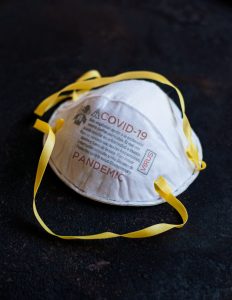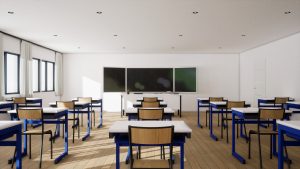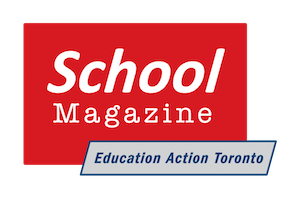Public health and safety experts call for improved conditions in schools
Low class sizes. Better air quality. Masks for all students and educators across the province.
These were three key messages put forward by experts asked to comment on the situation surrounding COVID-19 in Ontario schools. They were speaking at a virtual news conference this afternoon organized by Association des enseignantes et des enseignants franco-ontariens (AEFO), the Elementary Teachers’ Federation of Ontario (ETFO), the Ontario English Catholic Teachers’ Association (OECTA), and the Ontario Secondary School Teachers’ Federation (OSSTF/FEESO). The unions were planning to use their expertise at an Ontario Labour Relations Board (OLRB) hearing – but that is not going to happen.
The teachers’ unions filed a complaint at the end of August with the OLRB, asserting that the Ford government’s plans for return to school are unsafe. The Board refused to hear their arguments, claiming it doesn’t have the jurisdiction to do so. Today, lawyer Susan Ursel said that the Board had taken a narrow, technical interpretation of its responsibilities by maintaining that workplace problems need to be tackled one by one, classroom by classroom – a “low watermark,” in her view, for Ontario health and safety.
What about the students, families and educators affected by the decision?
Dr. Amy Greer, Associate Professor of Epidemiology at the Dalla Lana School of Public Health, called school a first line of defence to reduce disease transmission. If you can keep COVID-19 out of schools that will help to keep community  transmission low. Small classes, she added, allow for a minimum 2 metre distance to be maintained between students. This in turn, reduces the risk for secondary transmission of the disease and fewer students are affected if a class has to be shut down because one of its members has come in contact with the virus.
transmission low. Small classes, she added, allow for a minimum 2 metre distance to be maintained between students. This in turn, reduces the risk for secondary transmission of the disease and fewer students are affected if a class has to be shut down because one of its members has come in contact with the virus.
While keeping students in distinct groups or cohorts is critical in reducing transmission, Dr. Greer said, making cohorts out of large classes defeats the purpose. It just brings larger groups together, increasing contacts among students and educators. The same is true for calling a group of students a cohort when they’ve had the same number of pre-pandemic contacts. The risk isn’t reduced.
Her colleague at the Dalla Lana School of Public Health, epidemiologist Dr. David Fisman said that autumn is a vulnerable time for the spread of any virus. Students return to school; there are increased daily contacts and more opportunities to pass viruses to one another. COVID-19 travels in an “aerosol” form, typically about 1.5 metres out, as people talk and breathe around each other, but it travels further in spaces like classrooms where people tend to talk more loudly and project more air.
Small class sizes reduce the transmission of virus-laden aerosols, but so does wearing a mask. This applies both to sending and receiving as Dr. Fisman noted that, to some extent, masks reduce inhalation of viruses. Masks should not be optional for students above a certain grade. All students, from Kindergarten to grade 12 need to wear a mask in school.
He added that the belief that children under 10 are less likely to be infected or infectious – is probably wrong. As children are being tested for COVID-19 at higher rates, transmission rates are looking closer to those of adults.
Currently, the Toronto District School Board (TDSB) in-school class size limits are:
-
- JK/SK classes – 24 students, Grades 1 to 3 – 20 students
- Grades 4 to 8 – 27 students.
- Secondary – 15 students
NB: Communities identified by Toronto Public Health as higher risk for contracting COVID-19 will have JK/SK classes with a targeted limit of 15 students and Grade 1 to 8 classes with a targeted limit of 20 students.
Good air quality
It has been a generational struggle to improve maintenance and repair of schools, so it’s no surprise that air quality should be high on the to-do list of all school boards. Dr. Jeff Siegel is Professor of Civil Engineering at University of Toronto and a  specialist in indoor air quality. Good ventilation and filtration are key ingredients to reduce COVID-19 transmission. He referred to recent Ontario Ministry of Education Memo B-12 that focused on ventilation and filtration, as a place to start, noting that many schools should have better filters installed in forced air systems. Schools without forced air ought to be using portable HEPA filter systems. They are easy to deploy and flexible in addressing needs of different classrooms.
specialist in indoor air quality. Good ventilation and filtration are key ingredients to reduce COVID-19 transmission. He referred to recent Ontario Ministry of Education Memo B-12 that focused on ventilation and filtration, as a place to start, noting that many schools should have better filters installed in forced air systems. Schools without forced air ought to be using portable HEPA filter systems. They are easy to deploy and flexible in addressing needs of different classrooms.
With winter and dryer heated air coming, there will be a large problem with humidity. Aerosols travel further in dryer weather. So good ventilation is all the more important.
Options for further action
Lawyer, Susan Ursel said that there have been a number of incidents across the province that could give rise to further action with the OLRB by the teachers’ unions including numerous cases of elementary students becoming ill with or exposed to COVID-19, school closures due to an outbreak and concerns of parents that HEPA filter systems aren’t being properly deployed.
As far as individual teachers are concerned, they can contact their local health and safety representatives with concerns, bring widespread issues to the attention of health and safety committees and call in an inspector. Individual teachers, bearing in mind they have a responsibility to see to the immediate safety of their students, have a right to refuse unsafe work if they believe they are at risk of harm. They have the right to call in a Ministry of Labour inspector and right of appeal to the Labour Board.
Asked about a call by Minister of Education Stephen Lecce for teachers unions to co-operate with the Ford government, OECTA president Liz Stuart said that they have been trying to work with the Ministry since March but have been “shut down.” She went on to say: “This reopening needs to be sustainable.”
ETFO president Sam Hammond added that thousands of parents are moving the kids to online learning, not because it’s better but because they “aren’t comfortable” with in-class learning as it now stands. The Ministry and school boards should be implementing the recommendations of the experts above.
According to Dr. David Fisman, this is not the time to stop all in-school activities. It’s critically important to keep kids in school for the learning as well making sure that parents can get out to work. There are interventions governments can make before taking such a drastic step – reducing contact numbers, closing large gathering places where contacts are made and keeping class sizes low.


